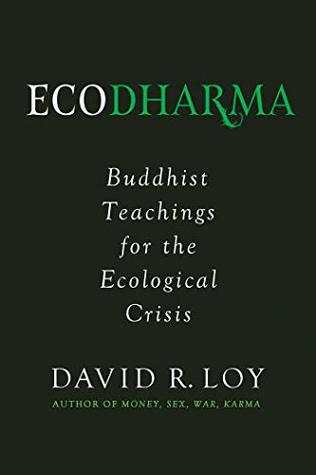Kindle Notes & Highlights
by
David R. Loy
Read between
September 19 - October 9, 2019
There is another way to understand the essential teaching of Buddhism. Instead of trying to transcend this world, or fit into it better, we can awaken and experience the world, including ourselves, in a different way.
although mindfulness practices can be very beneficial, they can also discourage critical reflection on the institutional causes of collective suffering, what might be called social dukkha.
If this instrumentalist view of the natural world is at the heart of our ecological predicament, perhaps the next development in overcoming hierarchical means–ends relationships is to appreciate that the planet and its magnificent web of life are much more than just a resource for the benefit of one species.
As Curtis White points out in We, Robots, “the National Park system is also our worst idea because it puts a boundary on nature beyond which we are free to be as destructive as we like.
Buddhism is not only what the Buddha taught but what the Buddha began — and we keep the tradition alive by keeping it relevant to our situation.
the basic problem isn’t what happened, it’s that “I” happened. Since the sense of self is a construct, it does not correspond to anything substantial. It’s not a real thing but a bunch of interactive functions: perceiving, feeling, acting, reacting, remembering, planning, intending . . . which means it is normally anxious and insecure, because there’s nothing there that could be secured.
The Buddhist solution to this predicament is not to “get rid of” the self. That cannot be done and does not need to be done, inasmuch as there never was a separate self to be gotten rid of. It is the sense of self that needs to be deconstructed (e.g., “forgotten” in meditation) and reconstructed (e.g., replacing the “three poisons” of greed, ill will, and delusion with generosity, loving-kindness, and the wisdom that recognizes our interdependence).
after bodhicitta arises one focuses on developing the six paramitas (“highest perfections”), attitudes that are cultivated and actions that are performed in a non-egocentric way.
The first paramita, dana
From the highest point of view, what I have is not mine because there is no me to possess it.
Sila, which can be translated as “virtue,” “right conduct,” or “discipline,” incorporates the ethical precepts of early Buddhism discussed earlier.
Kshanti, “patience,” means an endurance that never takes offense or avoids an uncomfortable situation.
Virya is variously translated as “energy” or “enthusiasm” or “sustained effort.” It involves extreme perseverence or diligence: never giving up, in order to accomplish what is wholesome and to avoid what is unwholesome.
Dhyana, “meditation,” refers to the cultivation of mental concentration or contemplative practices,
Prajna — literally, “highest knowing” — is the wisdom that accompanies awakening.
social justice issues and the ecological crisis are prompting reconsideration of the bodhisattva ideal.
what if one’s suffering is not always due to what one has done or is doing now? What about the massive amounts of collective dukkha caused by institutions and other social structures? How might conventional conceptions of the bodhisattva path be adapted, to make Buddhist teachings more relevant to such challenges?
ECOSATTVA
From a Buddhist perspective the basic problem is not rich and powerful “bad” people but institutionalized structures of collective greed, aggression, and delusion that need to be transformed.
Our task is to do the very best we can, not knowing what the consequences will be — not knowing if our efforts will make any difference whatsoever.


